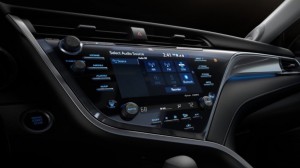It appears that Toyota is taking control — of its infotainment systems. As part of an announcement that its new 2018 Camry will be getting a new infotainment system the company revealed it will use open-source software from Linux.
Automotive Grade Linux, or AGL, is a group of more than 100 companies collaborating to develop and improve a common platform, which Toyota is using as the basis for Entune 3.0. Once it’s complete and deemed “successful” it will likely cascade over to other Toyota vehicles.
“The flexibility of the AGL platform allows us to quickly roll-out Toyota’s infotainment system across our vehicle line-up, providing customers with greater connectivity and new functionalities at a pace that is more consistent with consumer technology,” said Keiji Yamamoto, executive vice president, Connected Company of Toyota Motor Corp.
“Adopting an open source development approach has enabled us to focus resources on developing innovative new features and bringing them to market faster.”
There several advantages to using open-source software with perhaps the biggest one being time. Each new model often requires the maker to rewrite all of the code – more than 100 million lines of code – for the infotainment system from the ground up.
(Toyota lends a hand to flying car project. For the story, Click Here.)
However, with open-source software, more than two-thirds of the work is already done and Toyota just needs to focus on writing the code specific to the Camry, in this case. Toyota is the first maker to adopt AGL as the basis for its infotainment system. However, Suzuki, Daimler AG, Ford, Honda, Jaguar Land Rover, Mazda, Mitsubishi Motors, Nissan and Subaru are also working with it.
“It’s very necessary to reduce the overhead of duplication work among our suppliers so they can spend more time to create new things rather than maintaining fragmentary codes,” Kenichi Murata, group manager of Connected Strategy and Planning at Toyota, told Reuters.
The coding is what allows for the use of various apps that new vehicle buyers, especially younger buyers, are looking for these days.
Often, automakers simply set their systems up to pair with Apple’s CarPlay or Android Auto, which mimic the driver’s smart phone. It gives them access to all of the apps, such as Spotify or Pandora, they use on their phone.
(Click Here for how automakers dealt with a ransomware attack.)
And while that’s simple solution to a problem, it doesn’t allow Toyota or automakers to collect data about the user nor does it allow the automakers to customize their infotainment systems.
The use of AGL in the Camry isn’t the first time that Linux has been used in a production car. QNX, which is owned by BlackBerry, is a Linux variant used in many cars for infotainment functions. It is also the basis for Ford’s Sync 3 system.
Of course, there is a major downside to this kind of development. With so many involved in building of the system’s base, it may raise concerns about the security of the system.
Hackers have done all types of things to vehicles in recent years ranging from simply unlocking the doors to vehicles making easier to steal to actually taking control of a vehicle while its driving. Some experts see this kind of connectivity as a major security risk in a future that appears to be hurtling toward self-driving vehicles.
(Fighting car hacking is becoming big business. To see why, Click Here.)
Critics argue that it doesn’t take much to see how a current vehicle with it individually developed system could be used as a weapon by terrorists; it takes even less to imagine how it could happen with 70% of code written by many entities.

